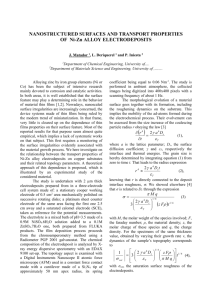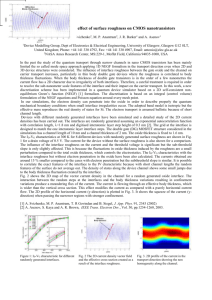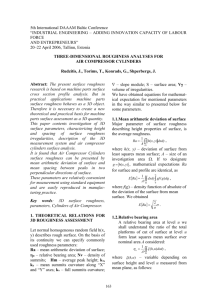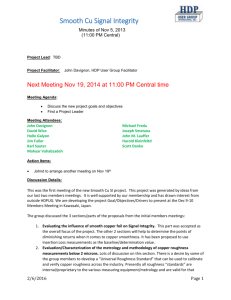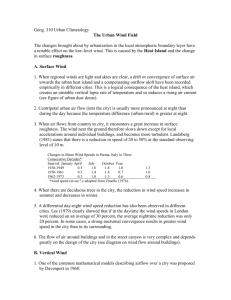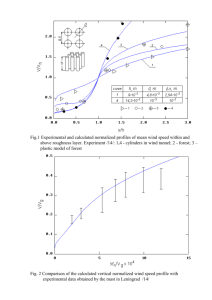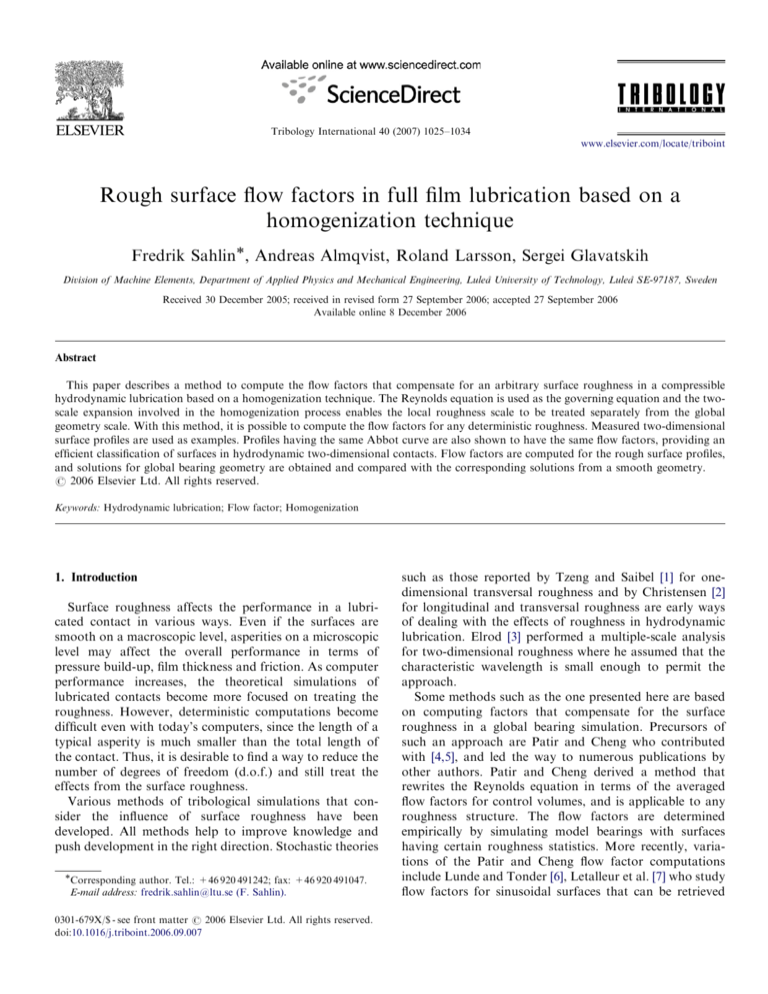
ARTICLE IN PRESS
Tribology International 40 (2007) 1025–1034
www.elsevier.com/locate/triboint
Rough surface flow factors in full film lubrication based on a
homogenization technique
Fredrik Sahlin, Andreas Almqvist, Roland Larsson, Sergei Glavatskih
Division of Machine Elements, Department of Applied Physics and Mechanical Engineering, Luleå University of Technology, Luleå SE-97187, Sweden
Received 30 December 2005; received in revised form 27 September 2006; accepted 27 September 2006
Available online 8 December 2006
Abstract
This paper describes a method to compute the flow factors that compensate for an arbitrary surface roughness in a compressible
hydrodynamic lubrication based on a homogenization technique. The Reynolds equation is used as the governing equation and the twoscale expansion involved in the homogenization process enables the local roughness scale to be treated separately from the global
geometry scale. With this method, it is possible to compute the flow factors for any deterministic roughness. Measured two-dimensional
surface profiles are used as examples. Profiles having the same Abbot curve are also shown to have the same flow factors, providing an
efficient classification of surfaces in hydrodynamic two-dimensional contacts. Flow factors are computed for the rough surface profiles,
and solutions for global bearing geometry are obtained and compared with the corresponding solutions from a smooth geometry.
r 2006 Elsevier Ltd. All rights reserved.
Keywords: Hydrodynamic lubrication; Flow factor; Homogenization
1. Introduction
Surface roughness affects the performance in a lubricated contact in various ways. Even if the surfaces are
smooth on a macroscopic level, asperities on a microscopic
level may affect the overall performance in terms of
pressure build-up, film thickness and friction. As computer
performance increases, the theoretical simulations of
lubricated contacts become more focused on treating the
roughness. However, deterministic computations become
difficult even with today’s computers, since the length of a
typical asperity is much smaller than the total length of
the contact. Thus, it is desirable to find a way to reduce the
number of degrees of freedom (d.o.f.) and still treat the
effects from the surface roughness.
Various methods of tribological simulations that consider the influence of surface roughness have been
developed. All methods help to improve knowledge and
push development in the right direction. Stochastic theories
Corresponding author. Tel.: +46 920 491242; fax: +46 920 491047.
E-mail address: fredrik.sahlin@ltu.se (F. Sahlin).
0301-679X/$ - see front matter r 2006 Elsevier Ltd. All rights reserved.
doi:10.1016/j.triboint.2006.09.007
such as those reported by Tzeng and Saibel [1] for onedimensional transversal roughness and by Christensen [2]
for longitudinal and transversal roughness are early ways
of dealing with the effects of roughness in hydrodynamic
lubrication. Elrod [3] performed a multiple-scale analysis
for two-dimensional roughness where he assumed that the
characteristic wavelength is small enough to permit the
approach.
Some methods such as the one presented here are based
on computing factors that compensate for the surface
roughness in a global bearing simulation. Precursors of
such an approach are Patir and Cheng who contributed
with [4,5], and led the way to numerous publications by
other authors. Patir and Cheng derived a method that
rewrites the Reynolds equation in terms of the averaged
flow factors for control volumes, and is applicable to any
roughness structure. The flow factors are determined
empirically by simulating model bearings with surfaces
having certain roughness statistics. More recently, variations of the Patir and Cheng flow factor computations
include Lunde and Tonder [6], Letalleur et al. [7] who study
flow factors for sinusoidal surfaces that can be retrieved
ARTICLE IN PRESS
F. Sahlin et al. / Tribology International 40 (2007) 1025–1034
1026
Nomenclature
Ra
Rk
Rq
Rsk
L
s
r
rmax
x
G
Lx
u
p
pc
average surface roughness, m
kurtosis of surface roughness
RMS surface roughness, m
skewness of surface roughness
h0 =Rq
standard deviation
surface roughness height, m
maximum surface roughness height, m
spatial coordinate direction, m
dimensionless surface roughness height,
r=rmax
fluid domain length in the x-direction, m
surface velocity in the x-direction, m/s
pressure, Pa
atmospheric pressure, Pa
analytically near contact, Wang et al. [8], who use the
Patir and Cheng approach and incorporate a contact
model and extend the problem into a mixed EHD model,
and Harp and Salant [9], who use the flow factor model
and formulate the flow problem to treat inter-asperity
cavitation.
Recent work has focused on homogenization techniques
when treating the surface roughness. The flow problem is
decoupled into two problems—the homogenized problem
on the macroscopic scale describing the bearing geometry
and the local (or cell) problem on the microscopic scale
describing the roughness. Examples of such work include
Kane and Bou-Said [10] who compare homogenization and
direct techniques, Jai and Bou-Said [11], who compare
homogenization and averaging techniques, and Bayada
et al. [12], who use a homogenization technique that also
treats the concept of cavitation.
In this work we present an approach to generate flow
factors that compensate for the surface roughness in the
full film hydrodynamic regime by using the homogenized
results of the compressible Reynolds equation presented by
Almqvist and Dasht [13]. The flow factors can be computed
for an arbitrary periodic two- or three-dimensional roughness, permitting the use of measured surface topographies
of real surfaces.
The advantages of computing flow factors this way
are its straightforwardness and rapidity, and its rigorous mathematical foundation and complete unambiguity
with only the roughness as input. The drawback of
an approach based on the findings of Patir and Cheng
[4,5] is the existing ambiguities in determining the flow
factors, e.g. how to truncate the solution of the local
problem to reduce the influence of the local boundary
conditions, such as Harp and Salant in [9]. In the current
work, a two-dimensional surface roughness is considered
and four measured surface profiles are used as a numerical
test case.
Z
r
rc
y
h
h̄
h0
b
G
e
x
fx
fs
c; w
N
a
dynamic viscosity, Pas
mass density, kg=m3
density at atmospheric pressure, kg=m3
dimensionless density, r=rc
fluid film thickness, m
nominal fluid film clearance, m
minimal fluid film clearance, m
bulk modulus, Pa
6Zu=b
wavelength measure of the local surface roughness scale
x=e
Couette flow factor
Poiseuille flow factor
solutions to the local problems
number of grid nodes for the cell problem
rmax =h̄
2. Theory
The current method is based on the Reynolds equation,
which is well suited for simulating thin fluid film flows in,
e.g., bearings. However, a simulation of a complete bearing
including the surface roughness is not feasible because of
the amount of d.o.f. required to resolve the roughness.
Therefore, a way to separate the effects of the surface
roughness from the effects of the global geometry of the
bearing is described. This method is completely unambiguous and mathematically well founded. A surface can be
well represented by using two geometry scales is assumed,
where one scale is much smaller than the other. Hence, the
total film thickness can be expressed as
hðxÞ ¼ h0 ðxÞ þ h1 ðx=eÞ;
e40,
(1)
where h0 represents the global geometry scale and h1 the
roughness scale, which is an arbitrary periodic function
expressed in one period with a wavelength parameter e. For
this condition, the compressible Reynolds equation is
homogenized by Almqvist and Dasht [13]. The homogenization process involves an asymptotic two-scale
expansion for the solution variable and allows e ! 0. This
permits the local and global problems to be treated
separately. Since the global problem does not involve any
rapid oscillations, fewer numbers of d.o.f. are required in
the solution process.
Now consider a measured two-dimensional surface
profile rðxÞ with a zero mean value. In the hydrodynamic
contact the profile and related measures are shown in
Fig. 1.
The film thickness of the lubricated contact can now be
expressed as
hðxÞ ¼ h̄ r.
(2)
The film thickness is constant in time and the stationary
compressible Reynolds equation constitutes the basis in
ARTICLE IN PRESS
F. Sahlin et al. / Tribology International 40 (2007) 1025–1034
1027
following dimensionless parameters:
h
H¼ ;
h̄
−r
G¼
r
;
rmax
a¼
rmax
;
h̄
x̄ ¼
6Zux
;
br2max
r̄ = 0
h0
h̄
Fig. 1. Film thickness and related parameters.
this work, viz.
d rh3 dp
u dðrhÞ
,
¼
dx 12Z dx
2 dx
H a ðxÞ ¼ 1 þ aðGðxÞ 1Þ;
(3)
where p is pressure, Z viscosity and r density. Expressing
the equation in terms of density as dependent variable is
convenient; hence, we define the dimensionless density as
r
y¼ ,
(4)
rc
where rc is the density at ambient pressure p ¼ pc . We
assume that p ¼ pðyÞ and it is therefore possible to apply
the chain rule on the pressure gradient, i.e.
dp dp dy
¼
.
dx dy dx
(5)
Substituting the expression for the pressure gradient and y
into the Reynolds equation yields
d yh3 dp dy
u dðyhÞ
.
(6)
¼
dx 12Z dy dx
2 dx
Assuming further that the bulk modulus, defined as
b¼y
dp
,
dy
(7)
can be treated as a constant, yields the following expression
relating pressure to density:
p ¼ pc þ b lnðyÞ
p
.
pc
(11)
Assume that a sufficient length of the surface is measured,
so that r can be seen as a periodic function. Then, let
r ¼ rðxÞ, which now corresponds to h1 in Eq. (1) where
x ¼ x=e and e corresponds to the wavelength of the period
constituted by the whole length of the surface measurement. In dividing Eq. (2) by h̄ and using the above
expressions, the dimensionless film thickness equation can
be written as
rmax
h
p̄ ¼
(8)
and the equivalent expression relating density to pressure:
p pc
y ¼ exp
.
(9)
b
Note that the constant bulk modulus gives rise to an
exponential expression for yðpÞ which is an acceptable
compressibility relation for a limited pressure range; see
[14] for a more comprehensive discussion regarding this
matter. Under this condition Eq. (6) can be written as
d
dy
dðyhÞ
h3
,
(10)
¼G
dx
dx
dx
where G ¼ 6Zu=b. To obtain a homogenized equation in a
more general form, independent of G, we define the
0pao1,
(12)
where the subscript indicates that a is a parameter. As a
goes from zero to one, the clearance h goes from infinity to
zero. It should be noted that the mean value of H always
equals unity and, as a decreases, H becomes smoother and
equal to unity for a ¼ 0. Substituting H a , p̄ and x̄ into
Eq. (10), the dimensionless form of the equation becomes
d
dy
dðyH a Þ
H 3a
.
(13)
¼
dx̄
dx̄
dx̄
Note that H a is periodic for all values of a. The
corresponding homogenized equation (see [13]) yields
d
dy
d
fxa
ðf yÞ,
(14)
¼
dx̄
dx̄
dx̄ sa
where
qc
H 3a ðxÞ 1 þ a dx and
qx
0
Z 1
3 qwa
¼
H a ðxÞ H a ðxÞ
dx.
qx
0
Z
1
fxa ¼
fsa
ð15Þ
c and w are solutions to the local problems on a unit cell,
i.e. the local roughness scales that are given by
q
qðH 3a Þ
3 qca
Ha
and
¼
qx
qx
qx
q
qw
qH a
H 3a a ¼
.
ð16Þ
qx
qx
qx
Integrating once with respect to x yields
qc
C a ¼ H 3a 1 þ a
and
qx
qw
Da ¼ H a H 3a a ,
qx
ð17Þ
where C and D are dependent only on the parameter a. By
integrating once more and utilizing the cell periodicity, i.e.
the periodicity of the surface roughness measurement, the
coefficients in Eq. (15) can be written as
Z 1
1
Z 1
1
Z 1
2
3
fxa ¼
H 3
dx
;
f
¼
H
dx
H
dx
sa
a
a
a
0
0
0
(18)
ARTICLE IN PRESS
F. Sahlin et al. / Tribology International 40 (2007) 1025–1034
and the partial differential equations have been reduced to
integrals of only powers of H because of the onedimensional dependence of the cell problem. For threedimensional surfaces the two integration steps above are
not feasible and partial differential equations still need to
be solved on the cell.
In the dimensionless Reynolds equation the local
problems are independent of G. Since the local problems
are solved on a unit cell domain, the physical spatial
properties of the roughness are diminished. This means
that the non-dimensionalization of x in Eq. (11) has no
influence on the solutions of the local problems, though the
local problem is dependent on the parameter a and the
special kind of measured surface roughness. This permits
the local problems to be solved for 0pao1, producing
flow factors fx and fs as functions of a, which contribute
from different roughness GðxÞ to a global coarse homogenized problem. With a database of previously computed
flow factors, the non-dimensional homogenized equation
can be directly solved on the non-dimensional coordinate x̄
to achieve the solution y. Instead of using the somewhat
inconvenient definition of x̄ the dimensionless homogenized equation can be directly scaled into a dimensional
form:
d
d
3 dy
fx ðxÞh̄ðxÞ
ðf ðxÞh̄ðxÞGyÞ,
(19)
¼
dx
dx
dx s
where fx and fs are the continuous function equivalences
of the parametrized fxa and fsa that are retrieved by
interpolation or curve fit to become functions of x.
The flow factors only depend on the particular surface
roughness and the nominal film clearance h̄ or a. In fact,
for two-dimensional surface profiles as presented here,
the flow factors only depend on, besides h̄ or a, the
height distribution of the surface roughness, i.e. the Abbot
curve.
3. Results
3.1. The effect of the two-scale approach
In the two-scale approach involved in the homogenization process, the wavelength measure e of the local
roughness scale is set to approach zero. This is obviously
not the case for real surfaces where the significant
roughness scales have finite wavelengths. However, if local
and global scales differ significantly in size the approach
could be motivated. To justify this assumption the
homogenization approach can be compared to a deterministic approach whose solutions are compared from a
geometry with a consecutively decreasing wavelength. For
shorter wavelengths the deterministic solution should
approach the homogenized. Consider the film thickness
equation
2px
h ¼ h0 þ A sin
,
(20)
eLx
× 10−6
hm
1028
5
4
Inlet, p = 0
0
0
Outlet, p = 0
u
xm
0.1
Fig. 2. A convergent gap geometry model with boundary conditions and
sinusoids as the periodic roughness. Here, two sinusoids are shown in the
same plot where e ¼ 25 and 23 .
where h0 is a convergent gap and A ¼ minðh0 Þ=10. This film
thickness is shown in Fig. 2 with two sinusoidal waves of
different wavelengths e shown in the same figure with
boundary conditions. Deterministic and homogenized
pressure solutions for this geometry are shown in Fig. 3.
As the wavelength decreases, the deterministic solutions
approach the homogenized. Good correspondence between
the deterministic and homogenized solutions is achieved
for a finite and relatively large value of the wavelength,
e ¼ 28 , corresponding to about 0.4 mm. This motivates
the treatment of the limit e ! 0 in the homogenization
process.
3.2. Flow factors
In this section four measured two-dimensional surface
topographies are used in the numerical examples. The
machining process and some of the surface parameters are
given in Table 1, where surface A greatly differs from the
other surfaces in Ra value. Surfaces B and D are quite
similar but differ significantly in skewness Rsk . The Abbot
curve for the four profiles can be seen to the left in Fig. 4.
This cumulative height distribution contains all height
information about a surface such as for example Ra , Rq ,
Rsk and Rk but no spatial information. Since the
simulations consider the dimensionless surface roughness
the cumulative height distribution in terms of G is shown
for clarity to the right in Fig. 4 where the mean value of G
equals unity. The results to be discussed are based on these
dimensionless height distributions that are used as one
wavelength of the periodic local roughness scale in the
homogenization process.
The surface measurements consist of 512 equally spaced
nodes, distributed on a length of 4:2 104 m. To
accurately compute the flow factors, the d.o.f. of the
measurement needs to be increased due to the non-linear
manipulations of H in Eq. (18). Since the measurement
points are the only information we have of the original
surface, a linear interpolation of the measurement is
performed, because it is assumed that no information will
be added or removed and the surface representation will
become identical to that of the measurements, only more
d.o.f. added to the solution process. To get an idea of the
sufficient grid resolution, the change of flow factors as
the grid spacing is reduced can be displayed. We define the
difference in solutions between two consecutive grid
ARTICLE IN PRESS
F. Sahlin et al. / Tribology International 40 (2007) 1025–1034
1029
110
108
ε = 2-4
ε = 2-6
ε = 2-8
Homogenized
p MPa
106
p MPa
100
104
102
50
100
98
0.065
0
0
0.05
xm
0.1
0.07
xm
0.075
Fig. 3. Pressure distribution along a converging gap with sinusoidal roughness for homogenized and deterministic cases (left) and a magnified part of the
domain (right) with different wavelengths for the deterministic cases.
Table 1
Data for the four original surface profiles
#
Additional
machining
rmax
ðmmÞ
Ra
ðmmÞ
Rq
ðmmÞ
Rsk
Rk
A
B
C
D
Phosphated & dephosphated
2.2
1.0
0.57
1.4
0.93
0.29
0.13
0.37
1.2
0.37
0.17
0.47
0.99
0.49
0.010
0.032
4.3
3.3
3.6
3.0
3chemically deburred
Shot-peened
All surfaces are uni-directionally ground and additional machining processes are shown.
4
4
A
B
C
D
0
3
G
r m
2
A
B
C
D
2
-2
1
-4
-6
0
0
20
40
(a)
60
80
100
0
(b)
%
20
40
60
80
100
%
Fig. 4. Abbot curve for the surfaces in dimension (left) and dimensionless (right).
spacings d and its double spacing 2d as
2d
d
b ¼ 2 jf f j ,
f
f2d þ fd
(21)
b is taken at some value of a. The convergence of f
b
where f
as the grid resolution is increased for surface A is seen in
Fig. 5, where the Trapezoidal and Simpson’s integration
rules have been compared for the integrations in Eq. (18).
The convergence for the problem where the differential
equations (Eq. (16)) have been solved through second order
differencing is also shown. Such differential equations need
to be solved for three-dimensional surfaces, though it
should be noted that the time required to solve Eqs. (15)
and (16) versus the integrals in Eq. (18) is almost 40 times
large. It can be seen in Fig. 5 that the grid resolution is
important for all solution methods. The differentiation and
the Trapezoidal rule integration methods show similar
convergence rates, but the Simpson’s rule integration
converges significantly faster than the other two. Because
the integrals of H are non-linear, the Simpson’s integration
rule will predict the correct integrals faster than the
ARTICLE IN PRESS
F. Sahlin et al. / Tribology International 40 (2007) 1025–1034
100
100
10-2
10-2
∧
φs
∧
φx
1030
Differentiation
Differentiation
Trapezoidal rule integration
Trapezoidal rule integration
Simpson’s rule integration
10-4 10
2
212
(a)
214
Simpson’s rule integration
10-4
216
N
210
212
(b)
214
216
N
Fig. 5. Flow factor convergence at a ¼ 0:98 as a function of spatial resolution for three computation methods.
10-2
10-4
∧
φs
∧
φx
10-2
10-4
A
B
C
D
10-6
210
A
B
C
D
212
(a)
214
10-6 10
2
216
212
(b)
N
216
214
216
N
α
0.49
α
0.49
100
10-2
10-2
∧
φs
∧
φx
100
A
B
C
D
10-4
10-6
(c)
214
210
A
B
C
D
10-4
212
214
10-6
216
N
α
0.98
(d)
210
212
N
α
0.98
Fig. 6. Flow factor convergence as a function of spatial resolution.
Trapezoidal. The Simpson’s rule for the flow factor
computations in Eq. (18) will be used in the continuation
of this paper.
b as
Fig. 6 shows a visualization of the convergence of f
the grid resolution is increased for all four surface
roughness profiles.
To achieve a good representation of the flow factors,
many points need to be interpolated into the original
profiles. The flow factors are more sensitive to grid
resolution for a value of a close to unity, i.e. close to
mechanical contact. However, the flow factors for a film
thickness approaching zero are rather uncertain regardless
of the resolution, since the hydrodynamic regime is
somewhat violated. In this paper we consider a resolution
of 216 grid nodes sufficient to compute the flow factors.
Finding classes of surface roughness that affect the
pressure in a hydrodynamic contact similarly is desirable,
i.e. having the same flow factors. Eq. (18) shows that the
coefficients of the homogenized Reynolds equation can be
written in terms of integrals of H. This means that the flow
factors for two-dimensional surface profiles depend only
on the Abbot curve. To numerically demonstrate this
property, Abbot curves from the original surface profiles
are used and the points at discrete levels of the curves are
randomly spatially distributed to produce surfaces having
the same Abbot curve. A fully randomized surface could
have the highest and lowest points as neighbours, which
would demand an extremely dense mesh. The distribution
of points is instead controlled by introducing certain rules
so that points are allowed to be positioned spatially close to
ARTICLE IN PRESS
F. Sahlin et al. / Tribology International 40 (2007) 1025–1034
existent points at a higher level. If this is not possible, new
peaks are formed from where points can be positioned at a
lower level.
Five profiles are created for each original surface profile
in the above manner and the standard deviation of fx
between the five randomized plus the original profiles are
plotted as a function of a in Fig. 7.
The standard deviation for each surface is small, as can
be seen by the figure, and reaches a maximum at a close to
one. The same applies for standard deviations of fs but
with a maximum of less than 3:5 107 . The standard
deviations approach zero close to a ¼ 0. Thus, it is also
shown numerically that the Abbot curve acts as an
unambiguous two-dimensional surface classification in
hydrodynamic lubrication with this homogenization
approach.
Finally, the flow factors for the four original surfaces
with 216 grid nodes are shown in Fig. 8 for the complete
range of a.
a ¼ 0 represents an infinite separation of the surfaces, or
in the dimensionless case, smooth surfaces. For this case,
the flow factors are unity for all surfaces, without any
influences from the roughness. As a increases, the influence
from the roughness increases. At the extreme of a ¼ 1, i.e.
A
B
10-8
C
σ
D
10-10
10-12
0
0.2
0.4
0.6
0.8
1
α
Fig. 7. Standard deviations of fx for the five random profiles and the
original profile for each surface where N ¼ 216 .
mechanical contact, no fluid can pass the asperities of the
surface roughness and the flow factors become zero.
Surface A has the roughest profile among the four and
constitutes the greatest flow restriction for most of the
a-range. However, at an a close to one, the A flow factor
shows a lower flow restriction than the other profiles. At
this zone, the flow factors become more sensitive to
profiles’ appearances at the asperity peaks.
3.3. Application examples
Some dimensional bearing examples where the computed
flow factors are used to solve the homogenized problem
will be shown. The non-dimensional flow factors for the
original profiles are used and scaled into dimensional flow
factors (see Section 2), allowing the homogenized equation
to be solved for the dimensional spatial domain. The flow
factors needed for the corresponding film thickness are
discretely retrieved by cubic spline interpolation from the
computed flow factors. In all simulations, the domain
length in the x-direction Lx ¼ 0:1 m; Z ¼ 0:14 Pas, b ¼
109 GPa; u ¼ 1 m=s and pc ¼ 105 Pa, which are also the
inlet and outlet Dirichlet boundary conditions. Side
leakage is not considered, since the one-dimensional
Reynolds equation is used and the load carrying capacity,
therefore, becomes greater than for two-dimensional
problems.
To verify if the local problems are adequately resolved in
terms of roughness resolution N to produce sufficiently
accurate solutions to the dimensional homogenized problems, the convergence in the load carrying capacity
between two consecutive grid densities, N, and its double
grid nodes equivalent, 2N, is computed as
Z Lx
jW 2N W N j
b
W ¼2
where W ¼
p dx.
(22)
W 2N þ W N
0
Fig. 9 shows the load convergence for the linear gap
geometry with h̄ ¼ ð6 10xÞ 106 m, as seen in Fig. 2
except with the measured profiles instead of the sinusoidal
waves as the roughness scale.
A uniform convergence rate is reached for a resolution
greater than N ¼ 211 . The load carrying capacity is
considered as sufficiently converged for a resolution of
1
0.8
0.8
0.6
0.6
φx
φs
1
0.4
0.4
A
B
C
D
0.2
A
B
C
D
0.2
0
0
0
(a)
1031
0.5
α
1
0
(b)
Fig. 8. Flow factors against a for all surfaces.
0.5
α
1
ARTICLE IN PRESS
F. Sahlin et al. / Tribology International 40 (2007) 1025–1034
1032
10-1
10
A
×107
S
A
B
C
D
B
10-2
8
C
6
10-3
p Pa
ˆ
W
D
4
10-4
2
10-5
210
211
212
213
214
215
216
0
N
0
Fig. 9. Convergence in load carrying capacity as a function of grid
b o2:8 105 for all surfaces at highest
resolution for converging gap. W
resolution with N ¼ 216 .
10
0.02
0.04
0.06
0.08
0.1
xm
Fig. 11. Pressure across the domain for a converging gap geometry,
h̄ ¼ ð4:4 4xÞ 106 m. The four original surface profiles are used and S
signifies a geometry without roughness.
×107
S
A
B
C
D
8
14
×107
A
B
C
D
12
10
p Pa
6
p Pa
8
4
6
4
2
2
0
0
0.02
0.04
0.06
0.08
0.1
xm
Fig. 10. Pressure across the domain for a converging gap geometry,
h0 ¼ ð3:4 4xÞ 106 m. The four original surface profiles are used and S
signifies a geometry without roughness.
N ¼ 216 , which is used when displaying all dimensional
results.
The pressure distributions in a convergent gap can be
seen in Fig. 10, where the four original surface profiles were
used as roughness and one geometry without roughness
marked S. The global geometry quantity h0 ðxÞ is the same
for all cases, i.e. all surfaces are equally close to mechanical
contact, see Fig. 1.
The differences in pressure build-up become large when
the problems for the same minimum clearance h0 for all
surface profiles are solved. The surface profiles are
significantly different in terms of rmax , thus h̄ will differ
considerably when keeping h0 the same. Of course, the
0
0
0.02
0.04
0.06
0.08
0.1
xm
Fig. 12. Pressure across the domain for a converging gap geometry with
constant tilt angle. The original surface profiles are used and minðh0 Þ is
scaled so that L ¼ 10 is kept constant in all four cases.
differences increase with a decrease in film thickness. The
roughest surface has the smallest pressure build-up,
whereas the smooth geometry produces the highest
pressure.
When comparing the pressure solutions achieved from
the original surface measurements again, though without
keeping a constant value of h0 , the mean separation h̄ is
kept constant in Fig. 11.
Here, the pressure profiles were shifted so that the
roughest surface, A, produces the highest pressure and the
smooth stands for the lowest. This is expected since
the roughest surface has material closest to the contact and
will restrict the flow the most when keeping h̄ constant.
ARTICLE IN PRESS
F. Sahlin et al. / Tribology International 40 (2007) 1025–1034
2
× 10-5
1.6
20
1.4
1.2
15
10
1
5
0.8
0.6
2
(a)
A
B
C
D
25
Λ
min (h0) m
30
S
A
B
C
D
1.8
1033
4
6
W N/m
8
10
×105
0
2
4
(b)
6
W N/m
8
10
×105
Fig. 13. The minimum film clearance (left) and the minimum L-value (right) as functions of load carrying capacity for the converging gap geometry. S in
the left figure indicates a smooth surface.
The smooth geometry S creates the smallest pressure and is
also furthest away from the contact. Due to the smooth
nature of surface C as well as the relatively large
separation, the pressure is close to that of surface S.
Therefore, to compare pressure distributions from different
surface roughness, the type of surface separation measure
to utilize (h0 , h̄ or other) becomes an important factor
depending on what properties are of interest.
Taking the reasoning concerning the surface separation
measure one step further, similar conditions as in the
previous two figures were applied in Fig. 12, i.e. with the
same angle of tilt of the converging gap. The difference is
the surface separation measure here governed by a
common value of L that is achieved by scaling the value
of h0 for each surface profile.
For these conditions, the smoothest surface C produces
by far the highest pressure. To keep the same value of L, h0
needs to be small for that surface profile. Since it is
relatively smooth compared to the other surfaces, the
lubricant flow restriction will be high. Surface A has a
negligible pressure build-up with this L-value.
Consider a converging gap geometry with maxðh0 Þ ¼
minðh0 Þ þ 1 mm. In Fig. 13 (left) the minimum value of h0
(see Fig. 1) is plotted as a function of load carrying
capacity for the rough profiles and a smooth, denoted S.
The ordering of the minimum film thickness follows
the ordering of Ra values for the roughness profiles,
with surface A standing for the smallest film thicknesses
and the smooth S for the largest. It is also clear from
the figure that as the film thickness increases the influence
of roughness decreases. The film parameter L is shown
instead of minðh0 Þ on the vertical axis to the right of
Fig. 13. Therefore, only solutions from the rough
surface are shown. By viewing the results this way, the
differences between the surfaces increase, especially for low
loads.
4. Conclusions
In this paper, a homogenization technique is considered
for the compressible Reynolds equation. This approach
involves an asymptotic two-scale expansion of the film
thickness. For a lubrication problem involving rough
surfaces, this method provides a mathematical approach
that separates the hydrodynamic effects at the local scale,
representing the surface roughness, from the hydrodynamic
effects at the global scale, representing the bearing
geometry. The conclusions are as follows:
A novel method of computing dimensionless flow
factors for arbitrary surface roughness using a homogenization technique has been developed.
The method provides flow factors for arbitrary global
geometries within the full film regime.
It has been shown that different two-dimensional
profiles having the same Abbot curve give the same
flow factors, thus providing an efficient classification
system for surfaces intended for operation in full film
lubrication.
Acknowledgments
The authors gratefully acknowledge the Swedish Foundation for Strategic Research for financing this research.
References
[1] Tzeng ST, Saibel E. Surface roughness effect on slider bearing
lubrication. SLE Trans 1967;10:334–8.
[2] Christensen H. Stochastic models for hydrodynamics lubrication of
rough surfaces. Int J Mech Eng 1970;184(55):1013–22.
[3] Elrod HG. A general theory for laminar lubrication with Reynolds
roughness. J Tribol 1979;101(1):8–14.
[4] Patir N, Cheng HS. An average flow model or determining effects of
three-dimensional roughness on partial hydrodynamic lubrication.
J Tribol 1978;100:12–7.
[5] Patir N, Cheng HS. Application of average flow model to lubrication
between rough sliding surfaces. J Tribol 1979;101:220–30.
[6] Lunde L, Tonder K. Pressure and shear flow in a rough
hydrodynamic bearing, flow factor calculation. J Tribol 1997;119:
549–55.
ARTICLE IN PRESS
1034
F. Sahlin et al. / Tribology International 40 (2007) 1025–1034
[7] Letalleur N, Plouraboue F, Prat M. Average flow model of rough
surface lubrication: Flow factors for sinusoidal surfaces. J Tribol
2002;124:539–46.
[8] Wang QJ, Zhu D, Cheng HS, Yu T, Jiang X, Liu S. Mixed
lubrication analyses by a macro-micro approach and a full-scale
mixed ehl model. J Tribol 2004;126(1):81–91.
[9] Harp SR, Salant RF. An average flow model of rough surface
lubrication with inter-asperity cavitation. J Tribol 2001;123(1):
134–43.
[10] Kane M, Bou-Said B. Comparison of homogenization and direct
techniques for the treatment of roughness in incompressible lubrication. J Tribol 2004;126(4):733–7.
[11] Jai M, Bou-Said B. A comparison of homogenization and averaging
techniques for the treatment of roughness in slip-flow-modified
Reynolds equation. J Tribol 2002;124(2):327–35.
[12] Bayada G, Martin S, Vazquez C. An average flow model of the
Reynolds roughness including a mass-flow preserving cavitation
model. J Tribol 2005;127(4):793–802.
[13] Almqvist A, Dasht J. The homogenization process of the Reynolds
equation describing compressible liquid flow. Tribol Int 2006;
39(9):994–1002.
[14] Sahlin F, Almqvist A, Glavatskih SB, Larsson R. A cavitation
algorithm for arbitrary lubricant compressibility. In: World tribology
congress III, Washington, DC, USA, September 2005.

